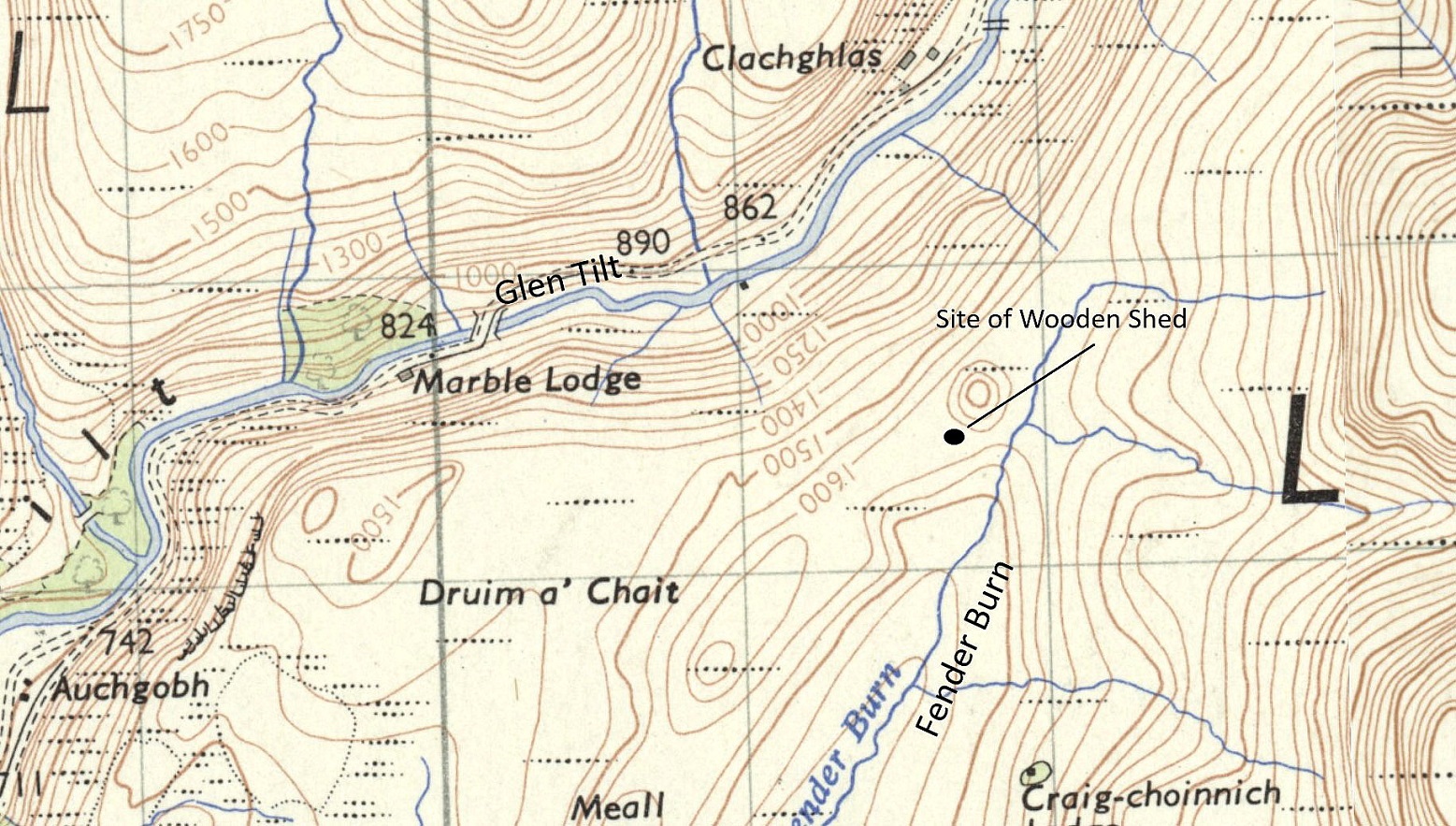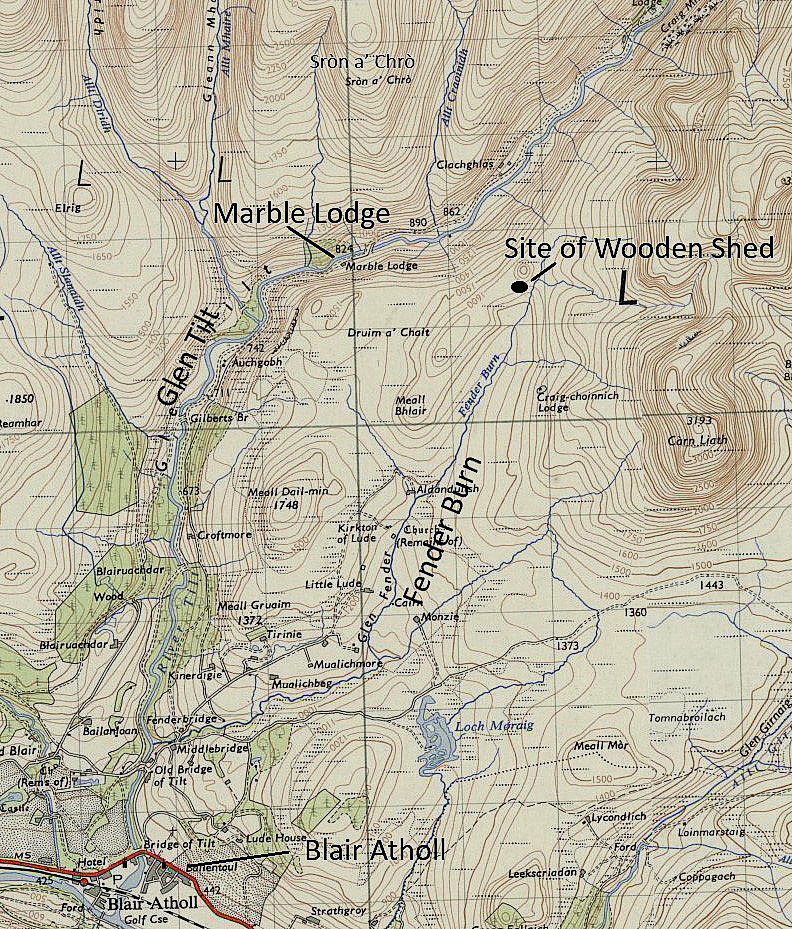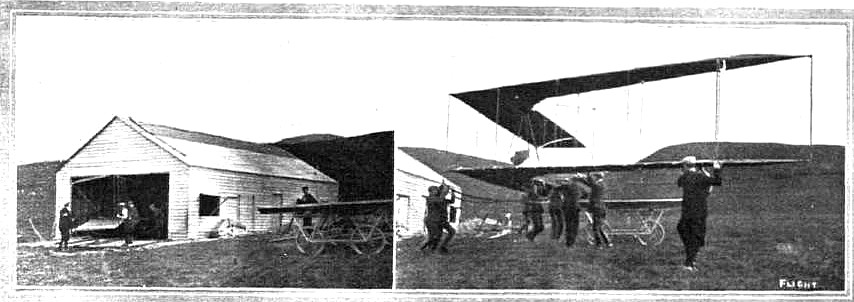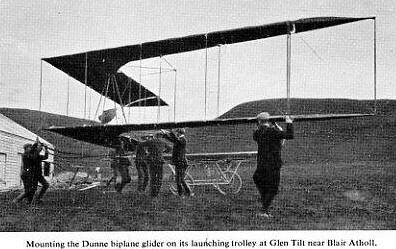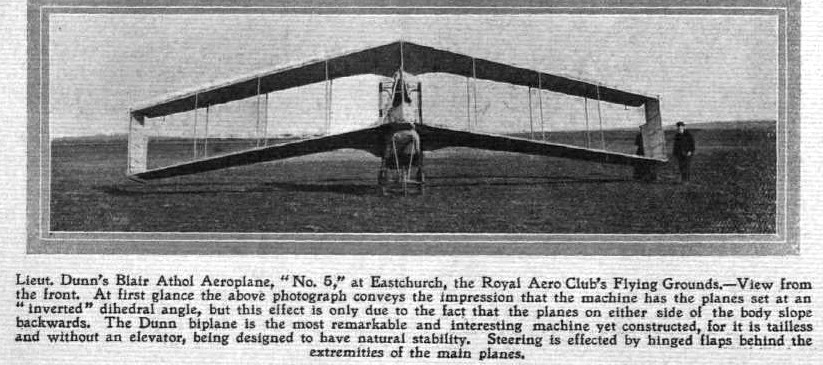Glen Tilt
Note: This map only gives a general idea of the location within the UK.
GLEN TILT: Early experimental powered flying site (See also BLAIR ATHOLL)
Note: These two maps were kindly provided by Mr Michael T Holder, who also found the pictures in the Flight magazine archives.
Note: This picture, scanned from the excellent book, British Aviation - The Pioneer Years, by Harald Penrose, first published in 1967, is captioned: "Mounting the Dunne biplane glider on its launching trolley at Glen Tilt near Blair Atholl." It appears that initially Capt. John W. Dunne, based at FARNBOROUGH, wanted the initial 'proof-of-concept' flight tests to be conducted with a glider - before an engine was added. Clearly, given the limited knowledge available of flying fixed wing aircraft in those days, Dunne was clearly pursuing a very cautious, (quite rightly of course), approach to developing his 'stable' aeroplane.
It is of course ironic, that the idea of a fully 'stable' aeroplane, which Dunne eventually developed, would soon prove to be entirely unsuitable for aeroplanes fit for operations in an aerial war where quick manoeuverabilty and aerobatic capability would be the key for surviving, if the pilot had the skill required.
NOTES: According to C C Turner experiments with the Dunne automatically stable aeroplane commenced here in 1907. Some newspapers carried stories of, “The mystery of the moors.” It appears it didn’t fly, hardly surprising with just a 15hp engine, but did it achieve 'hops'?.
It seems, once the news leaked out that the area was “besieged by spies, some of them German.” The Marquess of Tullibardine placed a security cordon of gillies around the area; “Whilst boys volunteered to guide visitors, but were careful to take them in the wrong direction.”
MORE NEWS
My notes above were made several if not many years ago, but in December 2020, Mike Holder who is a great friend of this 'Guide' unearthed these two articles, which quite clearly, show that the prospect of keeping these experiments secret was a lost cause. From the Inverness Courier published on the 17th September 1907 we learn:
ANOTHER VERSION
"The authorities in Blair-Atholl endeavoured, another correspondent says, ro satisfy public curiosity as to the nature of the operations going on among the hills by suggesting that astronomical observations were being carried out. The place where the shed has been erected is on a hill in Glen-Fender, east of what is known locally as the Marble Lodge, and is about five miles from Blair-Atholl. A number of officers and Royal Engineers are encamped at the place selected; eight tents in all provide their shelter from the uncertain climate away up in that savage district at the foot of Ben-y-Gloe."
"It is significant of the secrecy with which the authorities are carrying out the building of the aeroplane that the cook who attends to the inner wants of the officers and men has his tent pitched about three-quarters of a mile away from the shed. None of the men engaged have hitherto been seen in Blair-Atholl, and their experience up among the hills cannot be other than lonely."
"Now that the cat is out of the bag, great vigilance to ward off visits of prying persons is being exercised. The fact of the public having got wind of the Government's intention has rather annoyed the authorities at Blair-Atholl, chiefly in that they do not desire emissaries from foreign countries to know what is going on."
WHAT A FIASCO!
The whole enterprise was a complete nonsense from start to finish, and amply illustrates just how inept those in charge were. In so many ways illustrating the paranoia the military still have about keeping things secret. Indeed, by assembling this encampment, they achieved the exact opposite. It excited the curiosity of local people. And for what? Just another type of glider, the radical design of which would have meant little if anything to anybody else in the region. The means of keeping things secret, have of course, been developed beyond recognition since.
Mike Holder also found this article from the Pall Mall Gazette, dated 13 September 1907:
AN AEROPLANE FOR THE ARMY
________
SECRET WORK IN THE SCOTTISH MOUNTAINS
"The work of constructing the aeroplane on which the military authorities are engaged is being carried out among the Atholl Mountains, and within sight of the wilds of Badenoch. That they have been enabled to utilise so ideal a spot for their flying machine experiments is due to the patriotic instincts of the Duke of Atholl."
"No place so remote, so suitable, or so romantic could have found for an aeroplane station (says a "Daily Mail" correspondent). Trial after trial might take place and the machine in its flight be seen by none but a few close-lipped shepherds or taciturn gamekeepers. The chosen site is in the great valley of the Tilt. The river is a beautiful rapid-running stream, and passes to the right of and below the little camp."
"Mr. W. Dunn, (sic), Lieutenant Westland, and three other officers are carrying out the work. They are assisted by two non-commisioned officers of Royal Engineers, trained experts from the Farnborough balloon establishment, and attended by a few servants."
"The camp consists of eight tents, including a dining tent. About a quarter of a mile higher up the glen and on the edge of about the only flat piece of ground within miles is the large wooden shed in which is being put together the new aeroplane."
"Hardly a house is in sight of the camp, and the strictest precautions are taken to ensure privacy. The postman who walks miles from Blair Atholl to the camp is not permitted to approach within a certain distance. Any stranger is stopped before he reaches it."
"Work on the aeroplane will be finished before autumn is over, as operations in wind and snow-swept Glen Tilt are out of the question in winter. Every day sees an improvement in the mechanical details, and the young officers engaged will have their work supervised this week by Colonel Capper, of the Aldershot balloon establishment."
So much for secrecy then?
BONUS PICTURE:
Seen here with a much better engine, and no doubt proving just how good this stable design was. What is mostly lost, due to its unsuitability as a military machine, is just how advanced, in aerodynamic terms, Dunne's aeroplane was.
We'd love to hear from you, so please scroll down to leave a comment!
Leave a comment ...
Copyright (c) UK Airfield Guide















